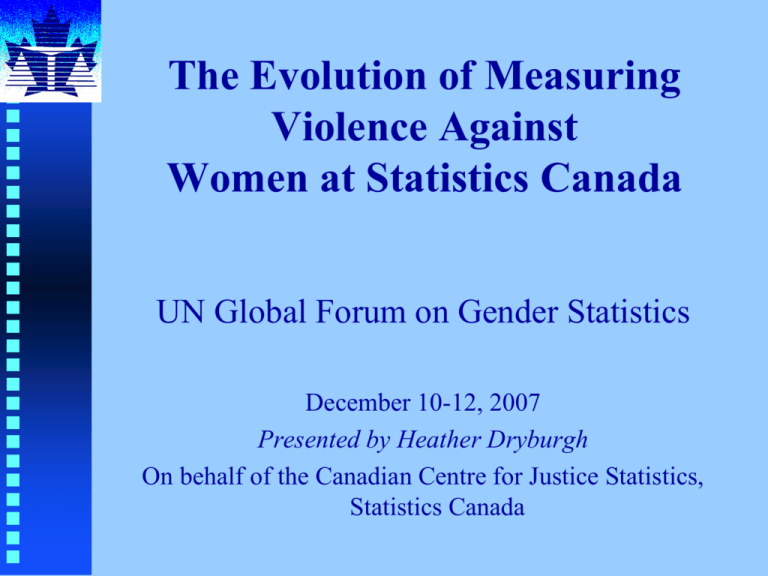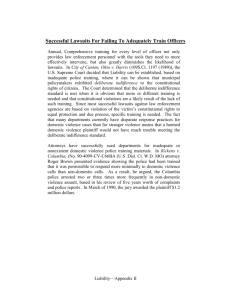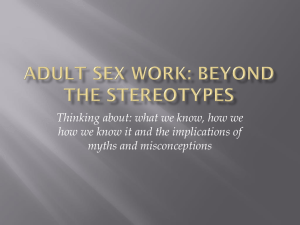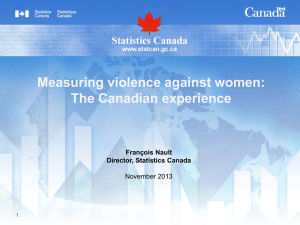General Social Survey
advertisement

The Evolution of Measuring Violence Against Women at Statistics Canada UN Global Forum on Gender Statistics December 10-12, 2007 Presented by Heather Dryburgh On behalf of the Canadian Centre for Justice Statistics, Statistics Canada Statistics Canada data sources to measure violence against women 1. Uniform Crime Reporting Survey (police data) 2. Homicide Survey 3. Victimization Surveys 4. Transition Home Survey 5. Victim Services Survey 6. Record linkage Police statistics – Uniform Crime Reporting Survey Collecting aggregate police statistics since 1962. In 1988 began collecting micro data from police forces. Victim and accused characteristics Incident characteristics Relationship of victim and accused Women represent a large majority of all victims of spousal violence reported to the police, 2004 30,000 25,892 (84%) 25,000 20,000 15,000 10,000 5,060 (16%) 5,000 0 Women Men Source: Statistics Canada, Canadian Centre for Justice Statistics, Revised Uniform Crime Reporting Survey, 2004 Police statistics - Homicide Survey Homicide Survey began in 1961. Began collecting data on family-related homicides in 1974. 1991 and 1997 revised and expanded Previous conviction history History of domestic violence Victim’s use of force at time of incident Rates of spousal homicide declined by half, 1974-2004 Female victims 18 16 14 12 10 8 6 4 2 0 1974 1978 1982 1986 Male victims 1990 1994 Source: Statistics Canada, Canadian Centre for Justice Statistics, Homicide Survey. 1998 2002 Risk of spousal homicide highest for young women, 1994 -2003 Rate per million 25 22.5 20 Slain wives Slain husbands 15 10 8.5 10.2 9.6 5.9 5 2.4 3 3.6 1.4 1 45-54 55+ 0 15-24 25-34 35-44 Source: Statistics Canada, Canadian Centre for Justice Statistics, Homicide Survey, 19942003. Advantages of police data Annual statistics Standard measure over time and among cities and provinces Criminal Code definitions Based on physical evidence and witnesses Disadvantages of police data Not representative of all crimes Little information about victims, ie., characteristics, consequences, outcomes Subject to changes in victim reporting, legislation, police policies, societal attitudes Statistics Canada’s Victimization Surveys General Social Survey on Victimization – 1988, 1993, 1999, 2004 1993 - Improvements made to better measure sexual assault 1999 - Special modules to measure spousal violence 2004 – Added a module to measure criminal harassment or stalking 1993 - National Survey on Violence Against Women Objectives of Measuring Violence Against Women Nature and extent of violence Dimensions of women’s fear Consequences and outcomes of violence Use of police and other services Theory testing, e.g. violence and pregnancy Policy development Rates of violence against women by relationship, since the age of 16 Total 51 Spouse/ex-spouse 29 Date/boyfriend 16 Other known man 23 Stranger 23 0 10 20 30 40 Percent Violence Against Women Survey, 1993 50 60 Measuring Spousal Violence Threatened to hit you in a way that could hurt you. Threw something at you that could hurt you. Pushed, grabbed or shoved you in a way that could hurt you. Slapped you. Kicked, bit, or hit you his/her fist. Hit you with something. Beaten you. Choked you. Use a gun/knife. Sexual Assault. Rates of wife assault by most serious type of violence Kicked, hit, beaten up, choked, gun or knife, sex assault 16 Pushed, shoved, slapped 11 Threats, threw something 2 0 Violence Against Women Survey, 1993 5 10 Percent 15 20 Emotional abuse by current and previous spouses/common-law partners He/she tries to limit your contact with family or friends He/she puts you down or calls you names to make you feel bad He/she is jealous and doesn’t want you to talk to other men/women He/she harms, or threatens to harm, someone close to you He/she demands to know who you are with and where you are at all times He/she damages or destroys your possessions or property He/she prevents you from knowing about or having access to family income, even if you ask Abuse report Physical injury by type of injury Sought medical attention, hospitalization Stay in bed/Take time off Partner’s alcohol use Anyone else harmed or threatened, including kids Children witnessed violence Fear for life Compensation Police intervention - why reported or not, satisfaction with actions Restraining orders Use of informal and formal supports (reason not used) Victim-offender mediation Emotional impact of violence Spousal violence more prevalent in previous unions Women Men % (5 years) 25 21 20 16 15 10 7 6 5 3 3 0 Total Source: General Social Survey, 2004 Current unions Previous unions Women experience more serious types of violence Male victims Female victims 15 Threats, threw something 11 Pushed, shoved, slapped 34 Kicked, bit, hit, hit with something 34 40 10 Beat, choked, gun/knife, sexual assault 16 39 0 5 10 15 20 25 % Source: General Social Survey, 2004 30 35 40 45 Violence against women has more serious outcomes 19 Injured 44 2 Medical attention Male victims Female victims 13 10 Feared for their lives 34 11 Assaulted more than 10 times 21 0 10 20 30 % Source: General Social Survey, 2004 40 50 Transition Home Survey Mail survey to all shelters (524) Bi-annual Characteristics of shelters and services One-day snapshot of women and children residents Victim Services Survey Mail survey to all victim services (606) Characteristics of victim services One-day snapshot of victims provided service Future efforts Continue monitoring trends through police reported statistics. Continue to include measures of spousal violence and criminal harassment on the GSS on Victimization (2009). Continue to undertake the Transition Home Survey and Victim Services Survey. Continue data linkage of police and courts files and move towards linking across systems to better understand case processing and outcomes of violence against women cases.








